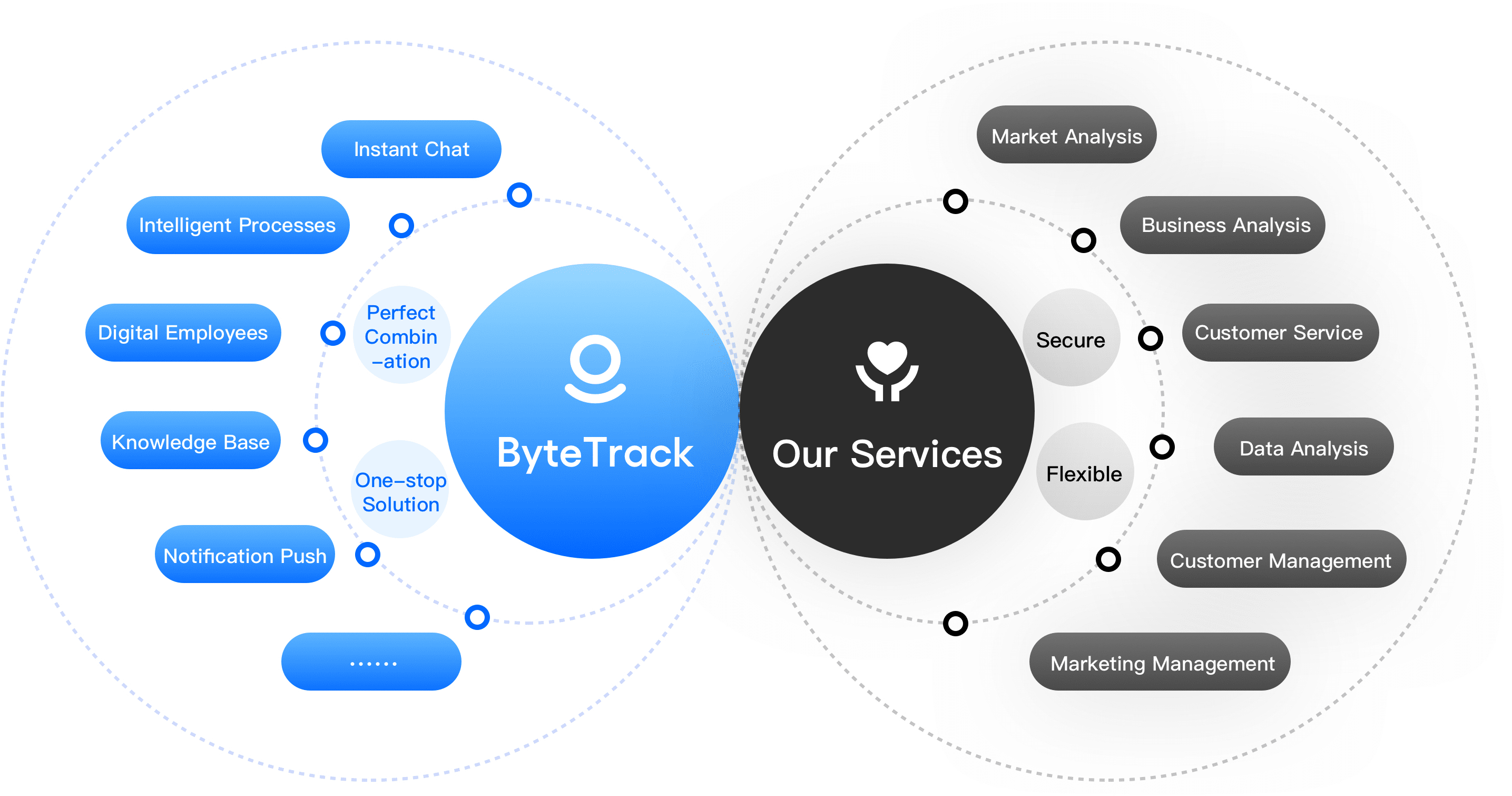ByteTrack System - Empowering customer service development through AGI
With the rapid development of the Internet, customer service system has become an important part of enterprise service and support. However, the traditional customer service model faces many challenges such as an increase in cases, personnel turnover, and cumbersome systems. This article will explore these pain points and introduce how ByteTrack empowers customer service systems through AGI (General Artificial Intelligence), demonstrating how intelligent customer service systems can provide enterprises with simple and efficient solutions, improve user experience, reduce operating costs, and jointly welcome the new era of customer service in the future.
The challenges and opportunities of customer service
With the vigorous development of the Internet industry for many years, the way users obtain enterprise services and support through the network has penetrated into their daily lives. More pre-sales consultation and after-sales service rely on the customer service system. This has led to huge challenges for the traditional customer service model:
The number of customer service cases increases, and enterprise investment is inevitable;
The loyalty of customer service personnel is low, the turnover rate is large, and the employment cost of enterprises is rising;
The traditional customer service system has large and cumbersome functions and low cost performance;

Figure: The current state of the customer service industry
The pain point of the traditional customer service industry is also the opportunity of the intelligent customer service system. With the development of artificial intelligence technology, the customer service system empowered by AGI (General Artificial Intelligence) can effectively solve the pain points in traditional customer service. Based on the concept of AGI intelligent customer service, ByteTrack came into being. As a minimalist AI intelligent operation platform, it can provide enterprises with a more simple and efficient customer service system. Enterprises can quickly access the customer service system in a non-intrusive way based on their own actual conditions. The combination of AI customer service and human customer service provides users with better services.
Functions and features of ByteTrack customer service system
Function:
Real-time communication: Through the concise and efficient chat function, build cross-platform and cross-channel communication and interaction channels, understand the real intentions of customers, and continuously improve the quality of communication services through self-learning.
Intelligent processes: Visually build automated processes without thresholds, plug and play, automate repetitive tasks, and use machine learning to continuously optimize and improve business processes to expand business possibilities.
Digital Employee: Driven by LLM, trained by the enterprise knowledge base, and based on AI large models, it can independently learn, adapt, and optimize, handle a large number of tasks in an intelligent way, and maintain conversational communication and interaction with customers and teams anytime, anywhere.
Knowledge base: Bring digitalization and personalization into article management, and accurately customize content according to customer interests and behaviors, and the final form of products/services from the aspects of content strategy, content creation, and content arrangement.

Figure: ByteTrack function
Peculiarity:
AGI intelligent support: The traditional customer service system combines AGI intelligent technology to provide high-quality customer service support for enterprise users through self-learning and intelligent strategies.
Extremely easy to use: The customer service system needs to be connected to the enterprise business system, and ByteTrack ensures the rapid access of the customer service system in a non-intrusive way. For the traditional customer service system, redundancy and refinement are eliminated, and the daily service needs of enterprises can be met in the simplest way.
Multi-channel support: An excellent AGI customer service system needs to be able to provide support on multiple platforms, whether it is an app, a computer, or html5 mode, which can allow enterprises to provide consistent services on platforms commonly used by customers, increase user interaction and engagement, help enterprises achieve omni-channel customer service operations, and enhance brand image.
Cost reduction and efficiency increase: *24 hours online customer service support; the time limit for responding to customer inquiries; Customer service satisfaction, etc., all require the enterprise to invest a lot of personnel, which increases the cost expenditure. AI customer service adopts the latest NLP model, and through self-learning and uninterrupted service capabilities, it can reduce customer service costs by 40% for enterprises.
ByteTrack grows with its customers
"When we first came into contact with AGI's customer service system, we were both excited and apprehensive. We are an educational institution, and the daily volume of user inquiries is very high, and the traditional customer service model has been difficult to meet our needs. At the recommendation of a friend, we tried to understand the technology of intelligent customer service. However, many products are difficult to access, and it is difficult for us to make a choice, until we encounter ByteTrack, and our worries disappear instantly. In the more than a year of cooperation with ByteTrack, our consulting efficiency has been greatly improved! "A real review of ByteTrack from an educational institution.
Nowadays, more and more enterprises are working with ByteTrack to change the traditional customer service model, and empower the customer service system through AGI to reduce costs and increase efficiency for enterprises.
The future of AGI customer service systems
Based on the existing development and needs, the future development of AGI customer service system will pay more attention to personalization, intelligence and comprehensiveness, aiming to improve user experience, improve service efficiency, and bring greater value to users and enterprises. Further progress will be made in the following areas:
Personalized service: Intelligent customer service will pay more and more attention to personalized service, and provide customized services and suggestions for each user by analyzing users' historical data and behavior patterns to improve user experience.
Multimodal interaction: In the future, intelligent customer service will not only be limited to text interaction, but will also integrate speech recognition, speech synthesis, image recognition and other technologies to achieve richer and more diverse interaction methods and better meet the needs of users.
Emotion recognition: Intelligent customer service will gradually have the ability to recognize emotion, analyze users' emotions and attitudes, and respond accordingly to provide a more humanized service experience.
Knowledge graph and context understanding: Intelligent customer service will have a deeper understanding of the questions raised by users, and combined with knowledge graph and other technologies, it can understand the context and provide more accurate and comprehensive solutions.
Natural language generation: Intelligent agents will gradually have the ability to generate natural language and be able to generate more fluent and natural responses, so that users can feel comfortable communicating with real people.
Cross-platform integration: Intelligent customer service will be integrated with various communication and social platforms to achieve seamless integration, users can access services through multiple channels, and achieve service continuity and consistency.
Brief summary:
ByteTrack, a simplified AGI intelligent operation platform, adopts the model of AGI + customer service to help enterprises reduce operating costs, reduce the difficulty of use, provide better user support for enterprises, and explore more user value.














One-stop solution, providing comprehensive support for business operations
ByteTrack,create a one-stop AI-based intelligent operational collaboration platform for you
- Resource
- ByteTrack academy
- Help center
- Developer center
- Contact us
-
 WeChat Official Account
WeChat Official Account Business WeChat ID
Business WeChat ID


 share
share


